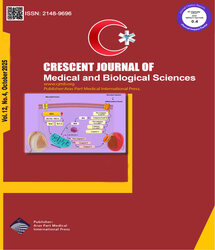

| Original Article | |
| The Relation of Lumbar Disc Herniation With Increased Lipid Hydroperoxide, Paraoxonase 1 and Total Oxidative Status | |
| Hamza Karabag1, Sezen Hatice2 | |
| 1Assistant Professor, Harran University Faculty of Medicine, Department of Neurosurgery, Sanliurfa, Turkey 2Assistant Professor, Harran University Faculty of Medicine, Department of Clinical Biochemistry, Sanliurfa, Turkey |
|
|
CJMB 2016; 3: 086-090 Viewed : 4181 times Downloaded : 4899 times. Keywords : Lumbar disc herniation, lipid hydro-peroxide, paraoxonase 1 |
|
| Full Text(PDF) | Related Articles | |
| Abstract | |
Objective: Lumbar disc herniation (LDH) is well known low back disorder. Beside a lot of reason, the chronic inflammation is stated to have a role in the importance of LDH. As known, there is a complex connection between inflammation and oxidative stress. The relationship between LDH and the levels of lipid hydroperoxide (LOOH), total oxidative status (TOS), paraoxonase 1 (PON1) and total antioxidative status (TAS) has not been studied until now. The purpose of this study was to evaluate the levels of oxidative markers, such as LOOH, TOS, PON1 and TAS in patients with preoperative stage of disc herniation. Materials and Methods: Fifty consecutive patients (8 patients were excluded; n = 42) with LDH and 50 healthy controls were subjected in this prospective study. Serum PON1, LOOH, TAS and TOS levels were determined. Results: Serum PON-1 level was found to be significantly lower (P = 0.008), serum TAS and LOOH levels were measured as significantly higher (both P < 0.001) in the LDH group than in the control group. Positive significant correlations were detected between LOOH and TAS, TOS, and oxidative stress index (OSI); then again between OSI and low-density lipoprotein cholesterol (LDL-C). Conclusion: The inflammatory-oxidant environment decreased PON1 and increased LOOH- may be the cause or reason of disc herniation. This result suggests that LDH may be related with atherosclerosis. |
Cite By, Google Scholar
Online Submission System
 CJMB ENDNOTE ® Style
CJMB ENDNOTE ® Style
 Tutorials
Tutorials
 Publication Charge
Medical and Biological Research Center
About Journal
Publication Charge
Medical and Biological Research Center
About Journal
Aras Part Medical International Press Editor-in-Chief
Arash Khaki
Deputy Editor
Zafer Akan

















